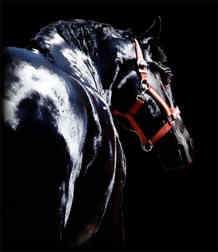
Normal behaviour can be divided into three categories:
1. Behaviour animals want to do,
2. Behaviour they need to do but only when external circumstances require it,
3. And behaviour they do not want to do.
Any behaviour that does not appear in feral horses is probably abnormal.
Healthy environment, physical health,
As horses are simple stomached ungulates, they
are trickle feeders, requiring large amounts of low nutrient dense feed all
throughout the day. They roam over
hundreds of miles not only in search of food and water but they are also
naturally coprophobic (i.e. in their natural environment they avoid dung).
Lavoie (1997) stated that horses kept permanently outdoors and fed
grass or good quality hay usually remained free from clinical signs of COPD.
As long as horses have access to shelter, water and enough good quality
food, they will survive quite happily. The
disease Summer Pasture Associated Obstructive Pulmonary Disease is similar to
COPD but occurs when the horse is at pasture during the summer.
The signs are very similar but it is ironic that the suggested treatment
is to stable the horse and feed it hay (Lavoie 1997)!
Horses at pasture spend nearly 70% of their
time grazing (McGreevy et al 1995b).
Adult horses are thermoneutral from about -10oC to + 10oC
(McBride et al 1983). This is
dependent on coat depth and air speed. Horses
are intolerant of draughts and are particularly susceptible to air quality,
especially ammonia, humidity, dust and mould spores.
These are physical stressors and are irritants and allergens to the
horse. In a stable the typical
ventilation rate requires for a horse is a minimum of 0.4 č0.7
m3h-1kg-1 with a maximum of at least 10 times
the minimum (Clark 1994).
Social
contact, psychological health,
Social contact in horses is very important, as they are herd animals. Allogrooming or mutual grooming has been shown to reduce heart rate (McGreevy 1998) and therefore has more important consequences in terms of stress reduction.
Keeping a horse, a social gregarious sentient
mammal, in a stable all the time in isolation, is a very considerable
psychological deprivation. Keeping
humans in isolation is a method of punishment. The horse that is not allowed to
mix and meet other horses has not had the chance of developing normal equine
communication, skills and manners. What people “think” is “best” for the
horse (i.e. to keep the animal in a stable) may be best for the person but worse
for the horse.
Exercise – freedom of movement,
There are two factors that influence feral horse behaviour, social organisation and the nature of the area that the horse covers in its search for food and water. The distance the horse covers depends on the availability of these resources. In the domestic situation, the horse is kept in a very intense environment, where water and food is close at hand and readily available. The food is sometimes in a concentrated form and can be consumed in 3-4 hours where the feral horse can eat for 16 hours or more.
TABLE - A comparison of various behaviours of domesticated horses, feral horses and zebra, (taken from Kiley-Worthington (1977)
